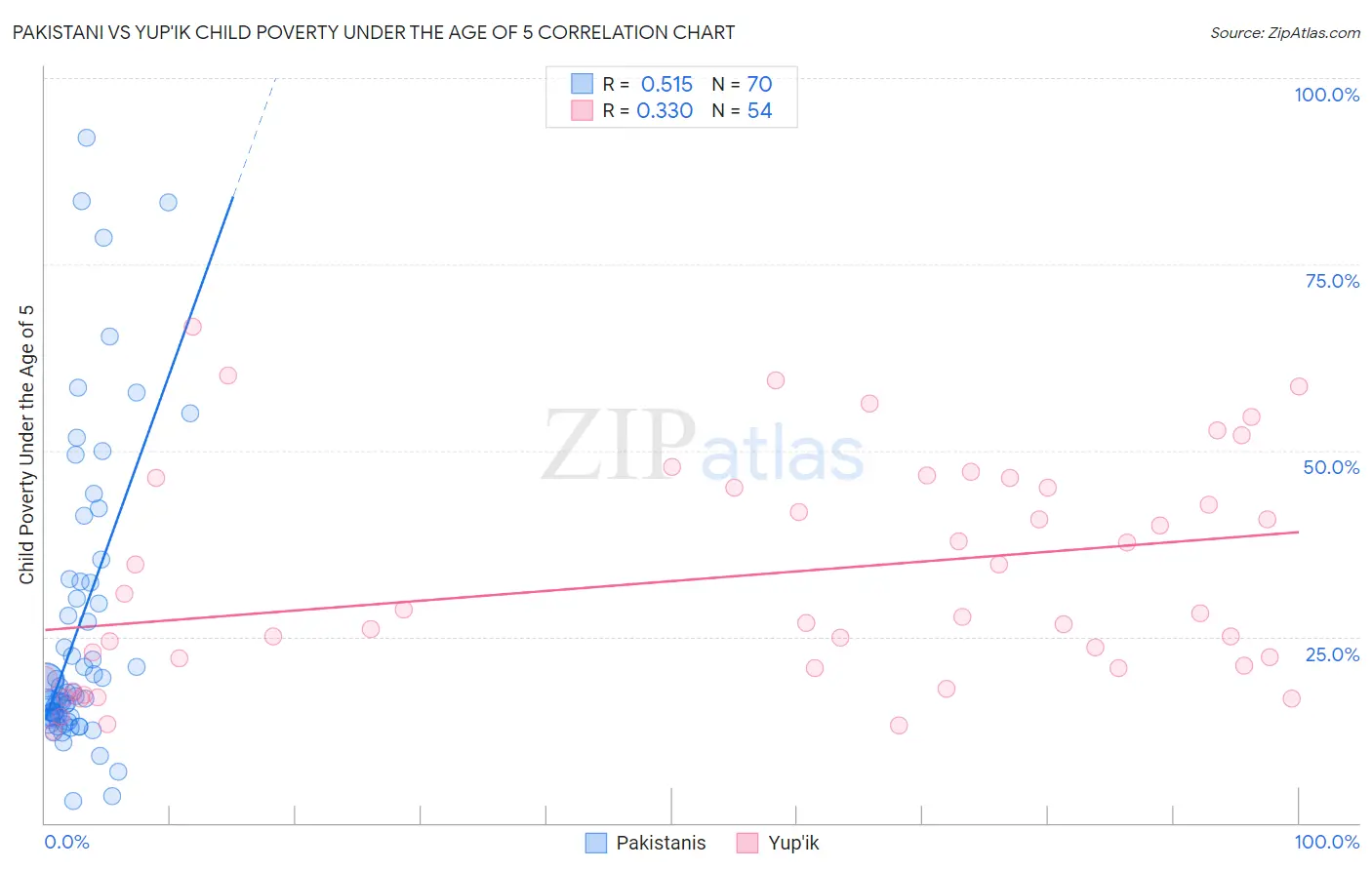Pakistani vs Yup'ik Child Poverty Under the Age of 5
COMPARE
Pakistani
Yup'ik
Child Poverty Under the Age of 5
Child Poverty Under the Age of 5 Comparison
Pakistanis
Yup'ik
16.0%
CHILD POVERTY UNDER THE AGE OF 5
94.2/ 100
METRIC RATING
111th/ 347
METRIC RANK
27.7%
CHILD POVERTY UNDER THE AGE OF 5
0.0/ 100
METRIC RATING
339th/ 347
METRIC RANK
Pakistani vs Yup'ik Child Poverty Under the Age of 5 Correlation Chart
The statistical analysis conducted on geographies consisting of 324,820,623 people shows a substantial positive correlation between the proportion of Pakistanis and poverty level among children under the age of 5 in the United States with a correlation coefficient (R) of 0.515 and weighted average of 16.0%. Similarly, the statistical analysis conducted on geographies consisting of 39,533,777 people shows a mild positive correlation between the proportion of Yup'ik and poverty level among children under the age of 5 in the United States with a correlation coefficient (R) of 0.330 and weighted average of 27.7%, a difference of 73.4%.

Child Poverty Under the Age of 5 Correlation Summary
| Measurement | Pakistani | Yup'ik |
| Minimum | 3.0% | 12.3% |
| Maximum | 92.0% | 66.7% |
| Range | 89.0% | 54.4% |
| Mean | 26.2% | 32.9% |
| Median | 17.3% | 27.8% |
| Interquartile 25% (IQ1) | 14.3% | 20.8% |
| Interquartile 75% (IQ3) | 32.3% | 45.0% |
| Interquartile Range (IQR) | 18.0% | 24.2% |
| Standard Deviation (Sample) | 19.9% | 14.7% |
| Standard Deviation (Population) | 19.8% | 14.6% |
Similar Demographics by Child Poverty Under the Age of 5
Demographics Similar to Pakistanis by Child Poverty Under the Age of 5
In terms of child poverty under the age of 5, the demographic groups most similar to Pakistanis are Northern European (16.0%, a difference of 0.040%), Romanian (16.0%, a difference of 0.040%), Peruvian (16.0%, a difference of 0.050%), Puget Sound Salish (16.0%, a difference of 0.060%), and Immigrants from Brazil (16.0%, a difference of 0.12%).
| Demographics | Rating | Rank | Child Poverty Under the Age of 5 |
| Immigrants | North America | 94.9 /100 | #104 | Exceptional 15.9% |
| Immigrants | Spain | 94.8 /100 | #105 | Exceptional 15.9% |
| Tlingit-Haida | 94.7 /100 | #106 | Exceptional 15.9% |
| Slovenes | 94.4 /100 | #107 | Exceptional 16.0% |
| Immigrants | Brazil | 94.4 /100 | #108 | Exceptional 16.0% |
| Northern Europeans | 94.3 /100 | #109 | Exceptional 16.0% |
| Romanians | 94.3 /100 | #110 | Exceptional 16.0% |
| Pakistanis | 94.2 /100 | #111 | Exceptional 16.0% |
| Peruvians | 94.1 /100 | #112 | Exceptional 16.0% |
| Puget Sound Salish | 94.1 /100 | #113 | Exceptional 16.0% |
| Immigrants | Kuwait | 93.9 /100 | #114 | Exceptional 16.0% |
| Albanians | 93.8 /100 | #115 | Exceptional 16.0% |
| Immigrants | Austria | 93.5 /100 | #116 | Exceptional 16.0% |
| Basques | 93.4 /100 | #117 | Exceptional 16.0% |
| Immigrants | Denmark | 93.4 /100 | #118 | Exceptional 16.0% |
Demographics Similar to Yup'ik by Child Poverty Under the Age of 5
In terms of child poverty under the age of 5, the demographic groups most similar to Yup'ik are Hopi (27.7%, a difference of 0.070%), Pima (27.4%, a difference of 1.1%), Cheyenne (28.3%, a difference of 2.2%), Sioux (26.9%, a difference of 3.0%), and Immigrants from Yemen (29.3%, a difference of 5.7%).
| Demographics | Rating | Rank | Child Poverty Under the Age of 5 |
| Apache | 0.0 /100 | #332 | Tragic 25.0% |
| Natives/Alaskans | 0.0 /100 | #333 | Tragic 25.6% |
| Blacks/African Americans | 0.0 /100 | #334 | Tragic 25.7% |
| Colville | 0.0 /100 | #335 | Tragic 25.7% |
| Sioux | 0.0 /100 | #336 | Tragic 26.9% |
| Pima | 0.0 /100 | #337 | Tragic 27.4% |
| Hopi | 0.0 /100 | #338 | Tragic 27.7% |
| Yup'ik | 0.0 /100 | #339 | Tragic 27.7% |
| Cheyenne | 0.0 /100 | #340 | Tragic 28.3% |
| Immigrants | Yemen | 0.0 /100 | #341 | Tragic 29.3% |
| Tohono O'odham | 0.0 /100 | #342 | Tragic 29.5% |
| Yuman | 0.0 /100 | #343 | Tragic 29.5% |
| Crow | 0.0 /100 | #344 | Tragic 31.0% |
| Navajo | 0.0 /100 | #345 | Tragic 31.6% |
| Lumbee | 0.0 /100 | #346 | Tragic 33.3% |